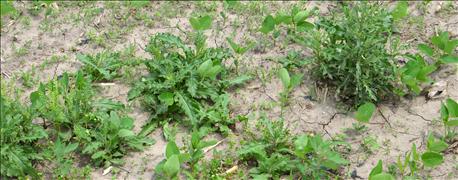
Suppose you have a field of soybeans that are 8 to 12 inches tall. You burned down weeds early, no-tilled into cornstalks and applied a residual herbicide after planting. A few broadleaf weed escapes are poking through here and there. Is it worth spaying again or not?
The panel of Indiana Certified Crop Advisers tackling this issue includes: Jamie Bultemeier, agronomist with A & L Great Lakes Lab, Fort Wayne; Gene Flaningam, independent crops consultant at Vincennes; and Bryan Overstreet, Purdue University Extension ag educator, Jasper County. Here is their take on your options.

TOO LATE TO SPRAY: Whether this constitutes a few escapes or a lot may depend upon your point of view. The winter annuals present will die, but the Canada thistle is much tougher to stop.
Overstreet: It depends on what species are breaking. For cocklebur or velvetleaf, it only takes four plants per 100 square feet to reduce yield by 6 bushels per acre. Waterhemp may take eight plants per 100 square feet to see the same yield reduction.
Bultemeier: The decision to pull the trigger on a post soybean spray application is always a challenging call. Ask yourself a few questions first. Are they winter annuals that will be done growing in a week or so? Did they survive your burndown? Could they be resistant? What species are present? Based on the post spray application you would use, how large a weed will the product(s) control?
Flaningam: Field weed history needs to be taken into account as a factor in this decision. Soybeans that are 8 to 10 inches tall still have a lot of growing season to take into account.
Bultemeier: In many cases these are weeds that germinated after the burndown application, but the residual did not have activity on them. Hopefully, this is all that will emerge.
Overstreet: If the species is Palmer amaranth you can see a reduced yield this year, but you want to worry about the amount of seed that will be produced for crops to compete with in the future. With that in mind, your threshold to treat Palmer escapes may be lower.
Bultemeier: If weeds are resistant to your residual herbicide, there are more [weeds] to come. Consider in the future adding an inexpensive post herbicide with your residual application. Or else, wait on doing your burndown so that you can apply both the burndown and the residual at the same time to avoid germination of weeds between applications.
Flaningam: Economics need to be considered. Cost of the spray application vs. yield gain will be the deciding factor. As noted by Bryan, the type of weed species and its ability to compete with the crop should also be considered.
About the Author(s)
You May Also Like




